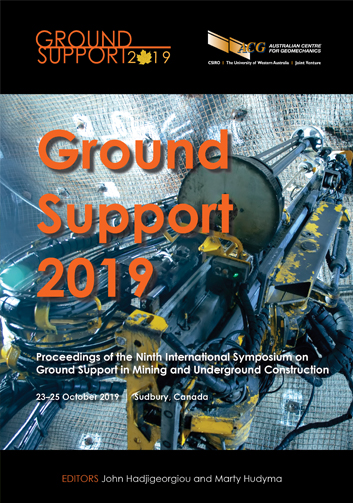Laser-based scanning to manage geotechnical risk in deep mines

|
Authors: Counter, DB |
DOI https://doi.org/10.36487/ACG_rep/1925_01_Counter
Cite As:
Counter, DB 2019, 'Laser-based scanning to manage geotechnical risk in deep mines', in J Hadjigeorgiou & M Hudyma (eds), Ground Support 2019: Proceedings of the Ninth International Symposium on Ground Support in Mining and Underground Construction, Australian Centre for Geomechanics, Perth, pp. 43-58, https://doi.org/10.36487/ACG_rep/1925_01_Counter
Abstract:
Kidd Creek mines has been either adopting new technology as it becomes available or adapting existing techniques to aid in assessing risk associated with ground and support systems failure, particularly risk associated with high-magnitude seismic events or significant deformation associated with mining at extreme depths. Over the past four years, the mine has used laser-based scanners as an aid in determining where and by how much the rock mass has deformed, both as a direct result of seismic events and as a function of rock mass deformation associated with mining. The scanning data is being used to qualify, if not quantify, how much strain has been introduced into the ground support systems, and it is being used as part of the rehabilitation and proactive re-support process to ensure that ground support systems have sufficient yield capacity remaining to withstand the largest possible future seismic event, in an effort to lower risk to personnel and mine production. Some recent data are presented along with a preliminary assessment of what the scanner information is capable of providing, and suggestions for future research are provided.
Keywords: laser scan, rockburst, support capacity, risk
References:
Beck Engineering Pty Ltd 2018, Abaqus Stress Model Sequence 19 Voxler Files, Technical Report and data provided to Glencore Canada Corporation, Kidd Mining Division.
Counter, DB 2014, ‘Kidd mine—dealing with the issues of deep and high stress mining—past, present and future’, in M Hudyma & Y Potvin (eds), Proceedings of the Seventh International Conference on Deep and High Stress Mining, Australian Centre for Geomechanics, Perth, pp. 3–22.
Hyett, AJ, Forbes, BP & Spearing, AJS 2013, ‘Enlightening bolts: Using distributed optical sensing to measure the strain profile along fully grouted rock bolts’, in T Barczak, D Caudill, G Lohr, SS Peng, S Tadolini, M Thompson & B Warnick (eds), Proceedings of the 32nd International Conference on Ground Control in Mining, West Virginia University, Morgantown, pp. 107–112
Lopez-Pacheco, A 2018, ‘Smart support—National Research Council brings ground support into the digital age with new rock bolt sensors’, CIM Magazine, vol. 13, no. 2, pp. 34–35.
Simser, BP 2007, ‘The weakest link: Ground support observations at some Canadian Shield hard rock mines’, in Y Potvin (ed.), Proceedings of the Fourth International Seminar on Deep and High Stress Mining, Australian Centre for Geomechanics, Perth, pp. 335–348.
© Copyright 2025, Australian Centre for Geomechanics (ACG), The University of Western Australia. All rights reserved.
View copyright/legal information
Please direct any queries or error reports to repository-acg@uwa.edu.au
View copyright/legal information
Please direct any queries or error reports to repository-acg@uwa.edu.au